

Home Page. Critical Thinking Model 1. To Analyze Thinking We Must Identify and Question its Elemental Structures Standard: Clarityunderstandable, the meaning can be grasped Could you elaborate further?
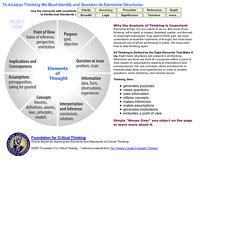
7 Poor Thinking Habits We Must Fix to Think More Critically. These 5 Practices Will Help You With Improving Critical Thinking Skills. Critical Thinking Exercises That Will Blow Your Students’ Minds. Editor’s note: This is an updated version of our article on critical thinking exercises that really stretch your learners’ abilities, with even more activities added. Real critical thinking exercises seek truth. 10 Team-Building Games That Promote Critical Thinking. Via TeachThought One of education’s primary goals is to groom the next generation of little humans to succeed in the “real world.”

DePaul University Teaching Commons. Metacognition, or thinking about one’s thinking, is key to facilitating lasting learning experiences and developing lifelong learners.

Linda Darling-Hammond and her colleagues (2003) identify two types of metacognition: reflection, or “thinking about what we know,” and self-regulation, or “managing how we go about learning. " Metacognitive activities can guide students as they: Identify what they already know Articulate what they learned Communicate their knowledge, skills, and abilities to a specific audience, such as a hiring committee Set goals and monitor their progress Evaluate and revise their own work Identify and implement effective learning strategies Transfer learning from one context to another Activities that promote metacognition should: Facilitate equal participation Ensure students do most of the talking Take place before, during, and after an experience Happen in different group configurations (individuals, pairs, small group, large group) Jumpstart Journal.
An Illustrated Book of Bad Arguments. A reader recently wrote in asking if I could share a bit about the process of putting the book together and talk about how the project started.

Certainly. I go on two solitary walks every day. Three Tools for Teaching Critical Thinking and Problem Solving Skills. As the world economy shifts away from manufacturing jobs and towards service industry and creative jobs, there’s a consensus among parents, educators, politicians and business leaders that it is crucial students graduate into university or the workforce with the ability to identify and solve complex problems, think critically about information, work effectively in teams and communicate clearly about their thinking.
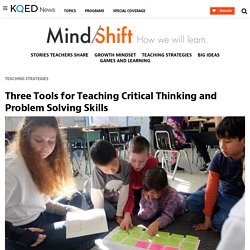
While many teachers agree with this premise, they don’t often know exactly how to teach these skills explicitly, especially because many of the mandates and required curriculum seem to push in the opposite direction. Process-oriented skills are hard to pin down; teachers can see them in certain students, but developing these competencies in students who aren’t already demonstrating them can be tricky. A few teachers in Ontario, Canada have been experimenting with tools they think could make the difference.
“I wanted the kids to realize there is no bad answer,” Watt said. How the 21st Century Fluencies Grow With Project-Based Learning. “Learning is not a spectator sport,” D.
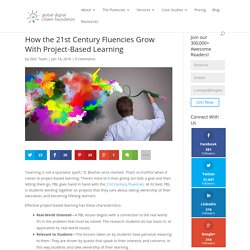
Blocher once claimed. That’s so truthful when it comes to project-based learning. There’s more to it than giving our kids a goal and then letting them go. PBL goes hand in hand with the 21st Century Fluencies. At its best, PBL is students working together on projects that they care about, taking ownership of their education, and becoming lifelong learners. 6 Strategies for Encouraging Critical Thinking. I recently helped my 9-year-old son to complete a homework project for his class that had him analyzing a news article, answering questions, and then translating it into a different language.
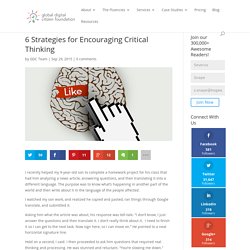
The purpose was to know what’s happening in another part of the world and then write about it in the language of the people affected. I watched my son work, and realized he copied and pasted, ran things through Google translate, and submitted it. Asking him what the article was about, his response was tell-tale. “I don’t know, I just answer the questions and then translate it. GIANT ROBOT FINGER ASSEMBLY. NOTE: There are 3 levels of difficulty - -from a simple one-piece finger, to a whole hand -- depending how far you go in the instructions.
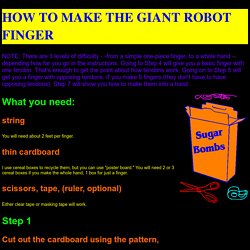
Going to Step 4 will give you a basic finger with one tendon. That's enough to get the point about how tendons work. Youtube. Thou shalt not commit logical fallacies. Genius Hour, Info Lit & Questioning. Tools for Writing: Points of View in Writing. There are three different points of view that can be used in writing: first person, second person, and third person.

In academic writing, the third person point of view is usually clearer and allows a writer to come across as more credible. Due to this and other reasons, the third person point of view is considered the best in academic writing. First person occurs primarily through the use of the pronoun “I.” This is the point of view used when a writer is writing about himself. There may be times when it is okay to incorporate personal examples into an essay, and if so, the first person will be used. Second person involves the use of the pronoun “you” to refer to the reader.
All beginning college students should learn how to write well. Notice the shift that occurred from the first sentence, which is written in the third person, to the second sentence, which is written in the second person. Writer's_Improvement_List_byPaulGreenberg_2014 - Google Sheets. 12 Angry Men1957.
#.VBcV8NGI70O. Crap Detection Resources. Mindset.jpg (JPEG Image, 3076 × 2302 pixels) - Scaled (33%) How To Become A Better Online Researcher. When we ‘research’ things now, we generally aren’t referring to spending time in a library – or even referring to spending time online accessing specific library or school research databases.

The word ‘research’ largely refers to the act of typing words into your internet search bar and seeing what the Wise Old Web tells you. There is so much information out there, and while a web search isn’t necessarily a bad thing (and we’d encourage you to head back to the ‘ol library to see what resources they have to offer you), there are definitely some things you can to do get the best search results possible out of a simple web search. Diversify Google is derived from the word googol, which roughly means a bunch. Specifically, it means ten raised to the power of a hundred (10100). Dig, Don’t Skim Don’t just skim the surface. Clarify You need to understand what you’re looking for before you start searching.
Use Modifiers Evaluate. An Illustrated Book of Bad Arguments. A reader recently wrote in asking if I could share a bit about the process of putting the book together and talk about how the project started. Certainly. I go on two solitary walks every day. There is a small park off the Embarcadero that is tucked away in a quiet spot. It has a pleasant stream flowing through it and an unassuming bench beside that stream. I have made walking to that frail bench a ritual, and the half an hour or so spent daydreaming on it amid the cool San Francisco breeze, an article of faith. It was on a day in October of last year when, during one of those quiet moments on that bench, I recalled my college years and how outspoken I happened to be during them, an observation only made interesting by the fact that I have since turned into the quietest of beings. Toulmin Model.
Stephen Toulmin, originally a British logician, is now a professor at USC. He became frustrated with the inability of formal logic to explain everyday arguments, which prompted him to develop his own model of practical reasoning. The first triad of his model consists of three basic elements: A claim is the point an arguer is trying to make. The claim is the proposition or assertion an arguer wants another to accept. The claim answers the question, "So what is your point? " How to Teach Critical Thinking. Robert H. Ennis, rhennis@illinois.edu The actual teaching of critical thinking is a function of many situation-specific factors: teacher style, teacher interest, teacher knowledge and understanding, class size, cultural and community backgrounds and expectations, student expectations and backgrounds, colleagues’ expectations, recent local events, the amount of time available to teachers after they have done all the other things they have to do, and teacher grasp of critical thinking, to name some major factors.
Teaching Critical Thinking Skills. Developing Students' Critical Thinking Skills Through Whole-Class Dialogue. Critical Thinking: Where to Begin. Critical thinking. Ten Takeaway Tips for Teaching Critical Thinking.
Suggestions from educators at KIPP King Collegiate High School on how to help develop and assess critical-thinking skills in your students. Ideally, teaching kids how to think critically becomes an integral part of your approach, no matter what subject you teach. But if you're just getting started, here are some concrete ways you can begin leveraging your students' critical-thinking skills in the classroom and beyond. 1. Critical Thinking : Academic Skills Centre. Critical Thinking Skills.